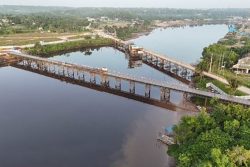The opening moments of “Tragic Jungle” feature its best sequence. We hear, before we see, the forested jungle that will define the narrative to come. Sounds of nature, the sounds of water, animal sounds. Brief images of the jungle appear and then the natural soundscape is interrupted by hacking. Men, with machetes, chopping away at the bark of a tree – the sap begins to leak in ways that seem dangerous. And so, the idyllic jungle become charged when put into contact with manmade violence. There’s a clarity of focus in that opening that I wish the rest of the narrative retained.
In the 1920s, in the jungle that borders British Honduras (now Belize) and Mexico, two stories clash. Agnes is a mixed-race young woman on the run from a vengeful landowner – and would-be husband – with two friends. Early on Florence, a Black woman accompanying her, questions her desire for escape. “You could have married that English guy,” she rationalises to Agnes. “If it was me, I would’ve let him feel in control a few times, and then I would have taken control of him. That’s how men are.” Agnes is repelled by the thought. “I’m not like you,” she tells Florence, setting up an initial distinction between Florence’s own carnal knowledge and Agnes’ initial piety.
Elsewhere in the jungle, a group of Mexican chicleros, harvesting tree-resin for gum, are planning to double-cross their boss and directly make a profit from their harvesting. They, too, are trying to outwit sources of power that would have them made subservient. When Agnes is violently separated from her party, the chicleros find her. She speaks no Spanish, and they speak no English. Concerned that she may betray their plan to their boss, they hold her captive and from there the inevitable tragedy awaiting the follies of men begins to unfold.
The jungle as a setting for tragedy in a kind of eco-gothic examination of power dynamic is not new, especially within a regional perspective of the Latin American and Caribbean landscape. Belize, as a continentally Central American country is, like Guyana, culturally a part of the Caribbean. The shared culture of the region is one that has been marked by colonial devastation that has sought to figure out, and then harness, the powers of the Caribbean landscape to terrible result. It’s a mark of colonisation that extends beyond the region – the journey into a mythical, evil jungle where the civilised man becomes increasingly untethered to reality.
It’s a compelling hook, and one that initially holds promise. Mexican director Yulene Olaizola has explored issues of identity and landscape in her work, and “Tragic Jungle” with opening narration from one of the chicleros, encourages us not to take the secrets and dangers of the jungle lightly. As Agnes is taken in by the men, Olaizola (she cowrites the film with Rubén Imaz) weaves an initially inviting account of murky uncertainty. The real-world escape plans of Agnes and the workers begins to intersect with the mythic when the narration interweaves the Mayan legend of the Xtabay into the narrative – a female jungle demon that lures lascivious men to their death. Saved from death at the beginning of the film, Agnes seems to slowly transition to Xtabay as she goes deeper into the forest. The weaving of mythical danger with the real-world danger of the colonisers in pursuit makes for a mosaic that starts out as compelling but soon begins to congeal in its frustrations.
“Tragic Jungle” is shot by cinematographer Sofia Oggioni with a distinct sense of place and context. Its idea of the jungle as an entity with its own sentience and personality is distinctive. “Everything seems to be the same colour,” the narration tells us of the landscape. But we know that that ostensible sameness is more nuanced. Oggioni’s camera knows that in the same way it investigates the gamut of greens and browns and blues in this sprawling jungle. But Oggioni’s awareness of nuance feels out-of-place with the narrative’s own singularity in considering what this “Tragic Jungle” really is.
It’s one thing for the humans to miss how nuanced the jungle is, but the film itself feels in-step with a flattened idea of the jungle as a location of one-dimensional abstrusity. As it begins to lean into overhead narration – telling but not showing – the nuance of the landscape and the value of the myth feel too nebulous to be register. Potential avenues of exploration feel too cursory in their use to really subvert the centuries-old ideas of the regional jungle as inherently foreboding and beyond understanding. There’s dramatic value in the jungle being beyond the realms of those who would do harm to it, but Olaizola’s idea of the jungle seems to offer little more than colonial ideas of regional landscape as a place where only animal instincts are unearthed.
The perspective would be more valuable if “Tragic Jungle” did not regard its human characters with such ambivalence. The potentially provocative class distinctions are unexamined. The relationship between the working class chicleros and their bosses, or the plantation-owner’s pursuit of a woman of colour, feels too sloppily rendered for us to consider the human desires that should buttress the narrative.
Olaizola, however, is effective at exploring the multiplicity of language in the region in ways that impress. “Tragic Jungle” moves between English, Creole, Spanish and Indigenous language. It speaks to the sprawling and polyphonic nature of identity in the Americas, emphasising a diversity of thought and identity that western presentations of the region often lack. This is not a myopic idea of the Americas as a one-coloured Latin American identity but recognises the ruptures inherent.
What it lacks is a distinct perspective on its own narrative. Yes, the jungle is mythical and hazy, but what does this mean for this story and these people? As an imagistic travelogue it is precise, but as story its ideas feel too nascent to affect. There is, for example, a more thoughtful engagement with Agnes’ escape operating in parallel to the yearning for escape that marks the chicleros narrative. There’s a range of possibilities in considering how the powerless end up turning on each other, only to benefit the oppressors. Yet, with so much terrain to explore, “Tragic Jungle” feels trapped by a limited perspective of these people and too indistinct to reckon with the postcolonial concerns beneath it beyond the schematic.
It looks good, and it sounds even better. The jungle is never silent. Even when men are not speaking the sounds permeate the soundscape, it’s alluring but also disorienting and ultimately chilling. Armed with machines, and guns, the men are no match for the secrets that the landscape holds. And as the landscape eats them up, one by one, there seems to be a deeper story there about how the land really belongs to no one. Perhaps the secrets of the landscape are even too much for Olaizola to handle. But rather than offering a perspective of the jungle myth that sees the local landscape as more than a bogeyman for “going savage” Olaizola seems content to suggest that to enter the jungles of the region is to head into the heart of darkness.
“Tragic Jungle” is currently streaming on Netflix










